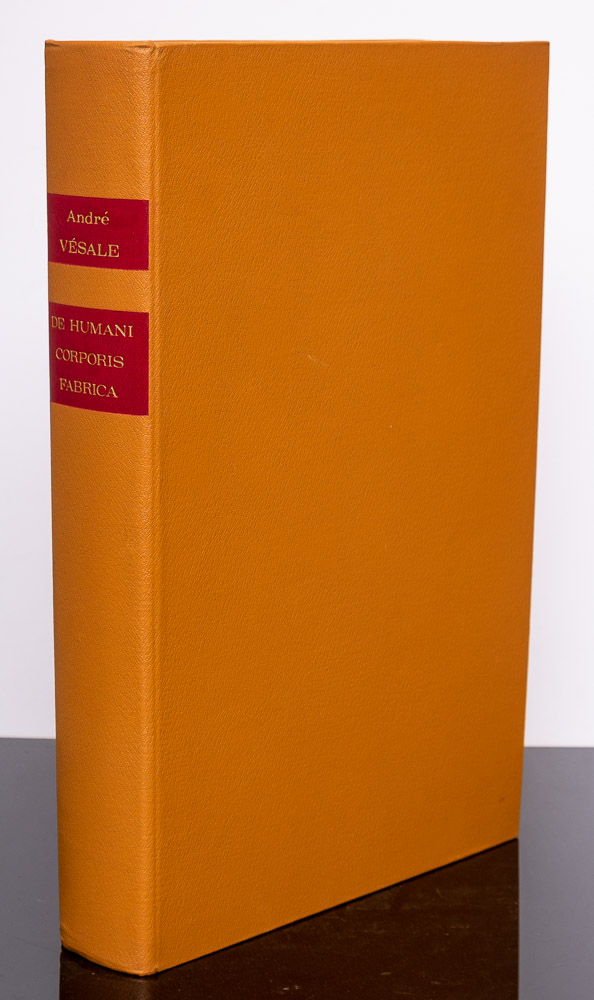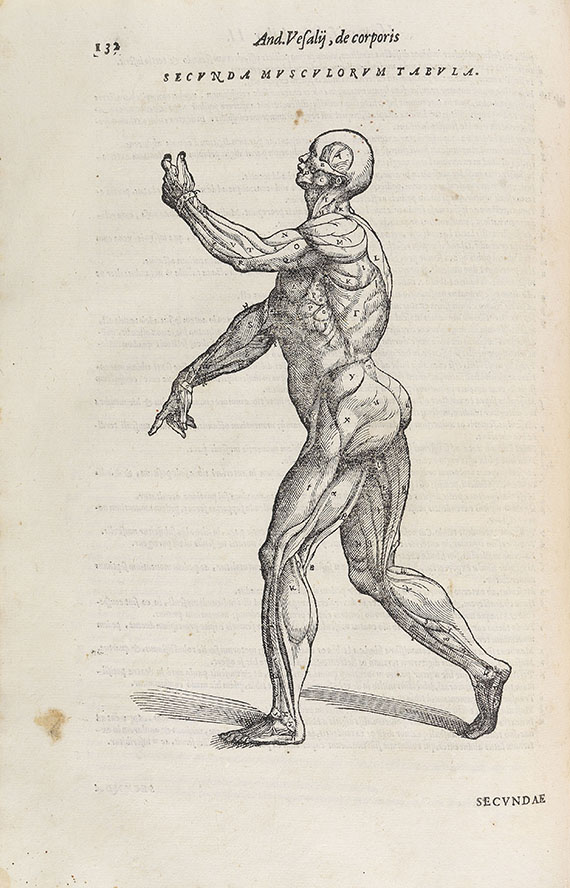VESALIUS, Andreas (1514-1564). De humani corporis fabrica libri septem . Basel: Johannes Oporinus, June 1543.
VESALIUS, Andreas (1514-1564). De humani corporis fabrica libri septem . Basel: Johannes Oporinus, June 1543. 2° (393 x 269 mm). Collation: * 6 ; A-Z 6 a-l 6 m 6 (2 + 1,2, the first inserted leaf a folding sheet, the second a half-sheet, both signed "m3") n-o 6 p 4 (3 + fold-out sheet signed p4) q-z 6 Aa-Ll 6 Mm 8 . 355 leaves and two folding sheets. Roman and italic types, occasional Greek and Hebrew types, printed shoulder notes. Typographic title printed in cartouche within full-page woodcut showing the author conducting a dissection in a crowded amphitheatre, author portrait, and printer's device; over 200 woodcut illustrations, including 3 full-page skeletons, 14 full-page muscle-men, 5 large diagrams of veins and nerves, 10 mid-sized views of the skull and brain, 2 mid-sized views of the thorax, 13 mid-sized views of the skull and brain, and numerous smaller views of bones, organs and anatomical parts; 7 large, 186 mid-sized, and 22 small woodcut initials. (A few minor marginal tears, some occasional light browning, Ii6-Ll6 with small repairs to blank inner margin affecting a few letters of shoulder notes, tiny wormhole at end.) 17th-century blindstamped pigskin over wooden boards, brass clasps and catches, edges stained blue (some light rubbing); red half morocco folding case. Provenance : Otto Oren Fisher (bookplate); Michael Sharpe (bookplate); from the collection of Richard Green. FIRST EDITION OF THE WORK THAT REVOLUTIONIZED THE SCIENCE OF ANATOMY . In contradiction to the usual practice of the time, Vesalius insisted that the study of human anatomy be based on close study of the human body. From his own observations, Vesalius corrected a number of errors made by Galen, whose theories were based on the dissection of animals. The larger amount of dissection material available to him inspired Vesalius to propose a new order of anatomical study, proceeding logically from the skeleton and muscles, through the blood vessels, nerves, abdominal viscera and thoracic organs, to the brain; this order is followed in the seven books of the Fabrica . Equally important and an even more radical break with tradition was Vesalius' insistence that the physician perform his own dissections. Vesalius demonstrated this new method of anatomical investigation in his popular lectures at the University of Padua, illustrated in the famous woodcut title-page of the Fabrica , which shows the author reaching into the abdomen of an opened cadaver. Following the publication of the Fabrica , when Vesalius was only 29, "all major investigators of anatomy were compelled to recognize the new principle, even though at first some paid no more than lip service to it... In the Fabrica Vesalius made many contributions to the body of anatomical knowledge, by description of structures hitherto unknown, by detailed descriptions of structures known only in the most elementary terms, and by the correction of erroneous descriptions... his contribution was far greater than that of any previous author, and for a considerable time all anatomists, even those unsympathetic to him, were compelled to refer to the Fabrica ... [But] more important than the anatomical information contained in the Fabrica was the scientific principle enunciated therein. This was beyond criticism, fundamental to anatomical research, and has remained so" (O'Malley, DSB article). A typographical masterpiece thanks to the learned and iconoclastic scholar-printer Johannes Oporinus, the Fabrica was also the first book of science to employ illustrations as an integral part of the scientific exposition. The more than 200 woodblocks were prepared in Venice under Vesalius' supervision and shipped to Oporinus in Basel with precise instructions as to their placement and letter-keyed captions. The finely drawn and anatomically precise woodcuts, by an unknown artist from the circle of Titian, brought anatomical illustration to a new level of realism. Totally interdependent, text and illustrations
VESALIUS, Andreas (1514-1564). De humani corporis fabrica libri septem . Basel: Johannes Oporinus, June 1543.
VESALIUS, Andreas (1514-1564). De humani corporis fabrica libri septem . Basel: Johannes Oporinus, June 1543. 2° (393 x 269 mm). Collation: * 6 ; A-Z 6 a-l 6 m 6 (2 + 1,2, the first inserted leaf a folding sheet, the second a half-sheet, both signed "m3") n-o 6 p 4 (3 + fold-out sheet signed p4) q-z 6 Aa-Ll 6 Mm 8 . 355 leaves and two folding sheets. Roman and italic types, occasional Greek and Hebrew types, printed shoulder notes. Typographic title printed in cartouche within full-page woodcut showing the author conducting a dissection in a crowded amphitheatre, author portrait, and printer's device; over 200 woodcut illustrations, including 3 full-page skeletons, 14 full-page muscle-men, 5 large diagrams of veins and nerves, 10 mid-sized views of the skull and brain, 2 mid-sized views of the thorax, 13 mid-sized views of the skull and brain, and numerous smaller views of bones, organs and anatomical parts; 7 large, 186 mid-sized, and 22 small woodcut initials. (A few minor marginal tears, some occasional light browning, Ii6-Ll6 with small repairs to blank inner margin affecting a few letters of shoulder notes, tiny wormhole at end.) 17th-century blindstamped pigskin over wooden boards, brass clasps and catches, edges stained blue (some light rubbing); red half morocco folding case. Provenance : Otto Oren Fisher (bookplate); Michael Sharpe (bookplate); from the collection of Richard Green. FIRST EDITION OF THE WORK THAT REVOLUTIONIZED THE SCIENCE OF ANATOMY . In contradiction to the usual practice of the time, Vesalius insisted that the study of human anatomy be based on close study of the human body. From his own observations, Vesalius corrected a number of errors made by Galen, whose theories were based on the dissection of animals. The larger amount of dissection material available to him inspired Vesalius to propose a new order of anatomical study, proceeding logically from the skeleton and muscles, through the blood vessels, nerves, abdominal viscera and thoracic organs, to the brain; this order is followed in the seven books of the Fabrica . Equally important and an even more radical break with tradition was Vesalius' insistence that the physician perform his own dissections. Vesalius demonstrated this new method of anatomical investigation in his popular lectures at the University of Padua, illustrated in the famous woodcut title-page of the Fabrica , which shows the author reaching into the abdomen of an opened cadaver. Following the publication of the Fabrica , when Vesalius was only 29, "all major investigators of anatomy were compelled to recognize the new principle, even though at first some paid no more than lip service to it... In the Fabrica Vesalius made many contributions to the body of anatomical knowledge, by description of structures hitherto unknown, by detailed descriptions of structures known only in the most elementary terms, and by the correction of erroneous descriptions... his contribution was far greater than that of any previous author, and for a considerable time all anatomists, even those unsympathetic to him, were compelled to refer to the Fabrica ... [But] more important than the anatomical information contained in the Fabrica was the scientific principle enunciated therein. This was beyond criticism, fundamental to anatomical research, and has remained so" (O'Malley, DSB article). A typographical masterpiece thanks to the learned and iconoclastic scholar-printer Johannes Oporinus, the Fabrica was also the first book of science to employ illustrations as an integral part of the scientific exposition. The more than 200 woodblocks were prepared in Venice under Vesalius' supervision and shipped to Oporinus in Basel with precise instructions as to their placement and letter-keyed captions. The finely drawn and anatomically precise woodcuts, by an unknown artist from the circle of Titian, brought anatomical illustration to a new level of realism. Totally interdependent, text and illustrations















Testen Sie LotSearch und seine Premium-Features 7 Tage - ohne Kosten!
Lassen Sie sich automatisch über neue Objekte in kommenden Auktionen benachrichtigen.
Suchauftrag anlegen